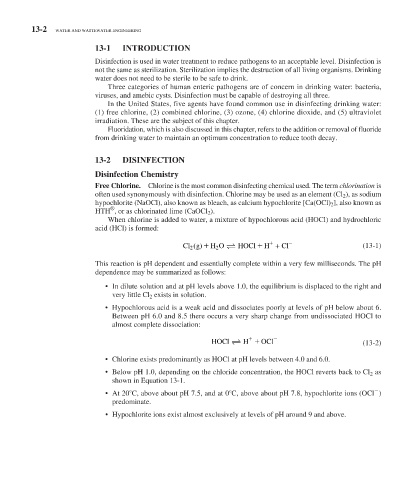Page 507 - Water and wastewater engineering
P. 507
13-2 WATER AND WASTEWATER ENGINEERING
13-1 INTRODUCTION
Disinfection is used in water treatment to reduce pathogens to an acceptable level. Disinfection is
not the same as sterilization. Sterilization implies the destruction of all living organisms. Drinking
water does not need to be sterile to be safe to drink.
Three categories of human enteric pathogens are of concern in drinking water: bacteria,
viruses, and amebic cysts. Disinfection must be capable of destroying all three.
In the United States, five agents have found common use in disinfecting drinking water:
(1) free chlorine, (2) combined chlorine, (3) ozone, (4) chlorine dioxide, and (5) ultraviolet
irradiation. These are the subject of this chapter.
Fluoridation, which is also discussed in this chapter, refers to the addition or removal of fluoride
from drinking water to maintain an optimum concentration to reduce tooth decay.
13-2 DISINFECTION
Disinfection Chemistry
Free Chlorine. Chlorine is the most common disinfecting chemical used. The term chlorination is
often used synonymously with disinfection. Chlorine may be used as an element (Cl 2 ), as sodium
hypochlorite (NaOCl), also known as bleach, as calcium hypochlorite [Ca(OCl) 2 ], also known as
®
HTH , or as chlorinated lime (CaOCl 2 ).
When chlorine is added to water, a mixture of hypochlorous acid (HOCl) and hydrochloric
acid (HCl) is formed:
Cl g () H O HOCl H + Cl (13-1)
2 2
This reaction is pH dependent and essentially complete within a very few milliseconds. The pH
dependence may be summarized as follows:
• In dilute solution and at pH levels above 1.0, the equilibrium is displaced to the right and
very little Cl 2 exists in solution.
• Hypochlorous acid is a weak acid and dissociates poorly at levels of pH below about 6.
Between pH 6.0 and 8.5 there occurs a very sharp change from undissociated HOCl to
almost complete dissociation:
HOCl H OCl
(13-2)
• Chlorine exists predominantly as HOCl at pH levels between 4.0 and 6.0.
• Below pH 1.0, depending on the chloride concentration, the HOCl reverts back to Cl 2 as
shown in Equation 13-1 .
• At 20 C, above about pH 7.5, and at 0 C, above about pH 7.8, hypochlorite ions (OCl )
predominate.
• Hypochlorite ions exist almost exclusively at levels of pH around 9 and above.

